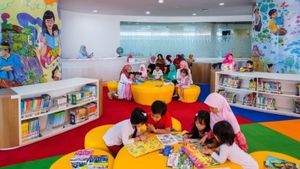YOGYAKARTA – Critical thinking is the ability to imagine, analyze, and evaluate information to determine its truth and quality. This skill is important for children because it helps them to form opinions and ideas. They will even know who is a good friend and who is not.
According to the Program For International Student Assessment (PISA) report published by Verywell Family, Friday, August 5, it has evaluated 15-year-old children in 44 different countries. More than one in six students in the United States cannot solve critical thinking problems. What's more, research shows that children who lack critical thinking skills are at a higher risk of behavior problems.
Not thinking carefully or thinking critically can lead to information being misinterpreted. If information is misinterpreted, it can cause problems at school, work, and relationships, says Amanda Pickeril, Ph.D., a licensed education practitioner with the Ohio Department of Education and the Ohio Board of Psychology.

Critical thinking also allows children to gain a deeper understanding of the world. That way, it helps children to understand themselves and their surroundings, helps solve problems, to be creative, and fosters independence. Teaching children to be critical thinkers can be done in the following ways.
1. Be a good role model
Often, the best way to teach children a certain skill is to model it. Children are also good imitators, meaning that parents can be role models for their children.
Make sure you are an example of a critical thinker in your own life. For example by researching things that sound untrue and opposing statements that seem unethical or unfair. According to Pickeril, critical thinking modeling allows children to observe their parents' thought processes and imitate what they observe.
2. With games
Play is learning, says Pickeril. Playing with children regularly is the basic setting for critical thinking and the depth of their critical thinking skills will develop according to their development. The key when playing with children is to spend quality time discussing things on a deeper level and critically examining issues.

3. Teach children to solve problems
The third way, teach children to solve problems. According to psychotherapist and author Amy Morin, LSCW., teach them to brainstorm at least five different ways to solve a particular problem. For example, you can challenge children to move certain objects from one room to another without using their hands. They can rack their brains by using their feet or even wearing gloves.
4. Encourage them to ask questions
Although it is tiring to answer a series of questions that are asked over and over again, it is important for children to ask questions. Asking questions is the foundation of critical thinking. By asking questions, children will learn how to articulate themselves and also identify information better.
5. Practice to make choices
Everything in life, must be tried. This is part of critical learning, namely by involving decision making. For example, allow them to say 'no thanks' if they don't want to do a certain thing. It could also be to give them an allowance and let them make some choices about what to do with it.
VOIR éGALEMENT:
6. Encourages open-mindedness
Encouraging an open mind may be a challenge for parents. However, with an open mind one can hone the skills to be objective and evaluate ideas without bias. So teach kids to look at things with an open mind, put judgment aside and talk about diversity, inclusivity and fairness.
Those are the six ways to teach children to be critical thinkers. By developing a critical mindset, children have life skills as they develop.
The English, Chinese, Japanese, Arabic, and French versions are automatically generated by the AI. So there may still be inaccuracies in translating, please always see Indonesian as our main language. (system supported by DigitalSiber.id)













